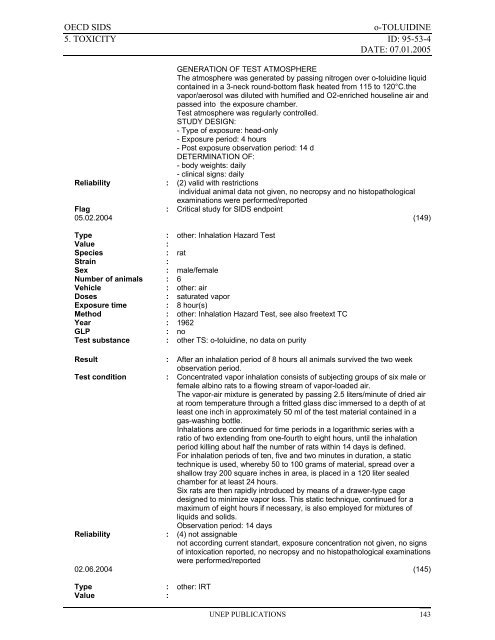o-TOLUIDINE CAS N°: 95-53-4 - UNEP Chemicals
o-TOLUIDINE CAS N°: 95-53-4 - UNEP Chemicals
o-TOLUIDINE CAS N°: 95-53-4 - UNEP Chemicals
You also want an ePaper? Increase the reach of your titles
YUMPU automatically turns print PDFs into web optimized ePapers that Google loves.
OECD SIDS o-<strong>TOLUIDINE</strong><br />
5. TOXICITY ID: <strong>95</strong>-<strong>53</strong>-4<br />
DATE: 07.01.2005<br />
GENERATION OF TEST ATMOSPHERE<br />
The atmosphere was generated by passing nitrogen over o-toluidine liquid<br />
contained in a 3-neck round-bottom flask heated from 115 to 120°C.the<br />
vapor/aerosol was diluted with humified and O2-enriched houseline air and<br />
passed into the exposure chamber.<br />
Test atmosphere was regularly controlled.<br />
STUDY DESIGN:<br />
- Type of exposure: head-only<br />
- Exposure period: 4 hours<br />
- Post exposure observation period: 14 d<br />
DETERMINATION OF:<br />
- body weights: daily<br />
- clinical signs: daily<br />
Reliability : (2) valid with restrictions<br />
individual animal data not given, no necropsy and no histopathological<br />
examinations were performed/reported<br />
Flag : Critical study for SIDS endpoint<br />
05.02.2004 (149)<br />
Type : other: Inhalation Hazard Test<br />
Value :<br />
Species : rat<br />
Strain :<br />
Sex : male/female<br />
Number of animals : 6<br />
Vehicle : other: air<br />
Doses : saturated vapor<br />
Exposure time : 8 hour(s)<br />
Method : other: Inhalation Hazard Test, see also freetext TC<br />
Year : 1962<br />
GLP : no<br />
Test substance : other TS: o-toluidine, no data on purity<br />
Result : After an inhalation period of 8 hours all animals survived the two week<br />
observation period.<br />
Test condition : Concentrated vapor inhalation consists of subjecting groups of six male or<br />
female albino rats to a flowing stream of vapor-loaded air.<br />
The vapor-air mixture is generated by passing 2.5 liters/minute of dried air<br />
at room temperature through a fritted glass disc immersed to a depth of at<br />
least one inch in approximately 50 ml of the test material contained in a<br />
gas-washing bottle.<br />
Inhalations are continued for time periods in a logarithmic series with a<br />
ratio of two extending from one-fourth to eight hours, until the inhalation<br />
period killing about half the number of rats within 14 days is defined.<br />
For inhalation periods of ten, five and two minutes in duration, a static<br />
technique is used, whereby 50 to 100 grams of material, spread over a<br />
shallow tray 200 square inches in area, is placed in a 120 liter sealed<br />
chamber for at least 24 hours.<br />
Six rats are then rapidly introduced by means of a drawer-type cage<br />
designed to minimize vapor loss. This static technique, continued for a<br />
maximum of eight hours if necessary, is also employed for mixtures of<br />
liquids and solids.<br />
Observation period: 14 days<br />
Reliability : (4) not assignable<br />
not according current standart, exposure concentration not given, no signs<br />
of intoxication reported, no necropsy and no histopathological examinations<br />
were performed/reported<br />
02.06.2004 (145)<br />
Type : other: IRT<br />
Value :<br />
<strong>UNEP</strong> PUBLICATIONS 143
















